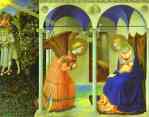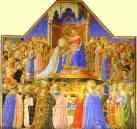Fra Angelico Biography
The life of Fra Giovanni da Fiesole, baptized as Guido di Piero (born around 1395 in Vicchio di Mugello, died in Rome in 1455) is the stuff of legend. "Angelic" was how he came to be known soon after his death; the name "Beato" was a comment on his painting and not a reference to his beatification, which happened only recently, in 1984.
Fra Angelico was a Dominican, and a mendicant, so, not being part of a closed order, he was free to meet and talk to others in the city. In 1420-1422, he entered the convent of San Domenico in Fiesole with his brother Benedetto. It was here that he produced his first works: altarpiece for the high altar, Altarpiece of the Annunciation, The Coronation of the Virgin, as well as the frescoes for his monastery.
Fra Angelico not only gained recognition as a painter, but must have commanded respect in his convent because he was appointed Vicario for the first time in Fiesole from 1432/33, a post he was to hold frequently in later years.
In the 1430’s the painter worked in Florentine churches. He carried out the following commissions for the Dominicans in Cortona: the Cortona Triptych and the Annunciation panel. From 1438, he worked on his most important commission, the San Marco Altarpiece and the frescoes for the convent of San Marco in Florence.
In July 1445 Fra Angelico was summoned by Eugenius IV to Rome, where he painted frescoes in the chapel of Santissimo Sacramento, which was later destroyed under Pope Paul III. For Eugenius’ successor, Nicholas V, he painted the frescoes of St. Stephen and St. Lawrence between 1447 and 1449 with the assistance of Benozzo Gazzoli (1420-1497), in the Capella Niccolina in the Vatican, named after the Pope who commissioned the frescoes.
In the summer of 1447, he began work on the frescoes in the Capella di San Brizio (10), in the cathedral at Orvieto. These were competed by Luca Signorelli fifty years later. From 1450-1452, he returned to his old convent in Fiesole as Prior, before going for one last time to Rome, where he died on 18 February 1455. He is buried in Santa Maria sopra Minerva, where his grave has always drawn worshippers. After his beatification by Pope John Paul II in 1984, the headstone was placed on a plinth and surrounded by a bronze grille with floral motifs. His feast day is 18 February, the day of his death.
Bibliography
Monumental Painting of Italian Renaissance. by I. Smirnova. Moscow. 1987. (in Russian)
The Art of the Italian Renaissance. Architecture. Sculpture. Painting. Drawing. Könemann. 1995.
Painting of Europe. XIII-XX centuries. Encyclopedic Dictionary. Moscow. Iskusstvo. 1999. (in Russian)
Fra Angelico at San Marco by William Hood. Yale University Press, 1993.
Fra Angelico: The San Marco Frescoes by Paolo Morachiello, Eleanor Daunt, Angelico, Museo Di San Marco. Thames & Hudson, 1996.
Fra Angelico: Dissemblance and Figuration by Georges Didi-Huberman, Jane Marie Todd. Press, 1995.
Fra Angelico by John T. Spike. Abbeville Press, 1995.
- Altarpiece Of The Annunciation.

c. 1430-1432. Tempera on panel. 194 x 194. Museo del Prado, Madrid, Spain. Read Note.
- The Coronation Of The Virgin.

Tempera on panel. 213 x 211. Louvre, Paris, France. Read Note.